OTTOMAN BANKNOTES AND COINS
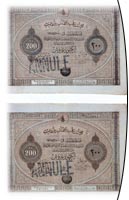
1st Emission 1st Arrangement (Istanbul ) 200 kurush banknote (TL), serial number 000002, exported on 16th November 1863, with the seal of Sultan Edhem and the signatures of Alleon and Falconnet. These words written on a later date can be read on it as "5th July 1890. Given by Mr. Ch. Holmes and received as a sample. Kept by the late Sir Frederic W. Smythe.
1st Emission 1st Arrangement (Istanbul) 200 kurush banknote's rear face (TL), 005067 serial number, exported on 16th November 1863, which will be paid the equivalent in silver is found on the front face.
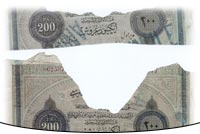
1st Emission (Izmir) pieces of a 200 kurush banknote (OBA) the part with 02587. Serial number belongs to the IV arrangement, as for the others they are understood to be from the IV or V Arrangement from the visible signature of sandik emini (treasurer) and the application of the signature of Cramer.
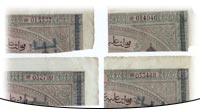
1st Emission 200 kurush banknote corners. (OBA) 0332799 and 033448 serial numbered pieces. V Arrangement (Izmir). It is certain that they belong to banknotes. It is shown once again that besides these numbers the empty spaces in the number ledger between 31,001-39,0000 are in use. As for the corners with the serial numbers 013337 and 014946, it is possible that they are from the II Arrangement (Istanbul) or III Arrangement (Izmir).
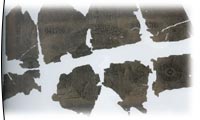
1st Emission 2nd Arrangement. Pieces of a 5 lira banknote (OBA) 041788 serial number. Exported on the 17th January 1874. Alleon and Smythes signatures can be read.
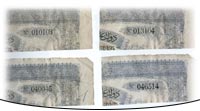
1st Emission 2nd Arrangement 5 lira banknote corners (OBA).
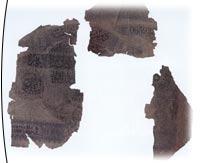
1st Emission 3rd Arrangement, pieces of a 5 lira banknote. (OBA) 065932 serial number. Exported on the 11 May 1875. A very small part of the stamp of Ohannes Çamiç Efendi's seal can be seen. Smythe signature can clearly be seen.
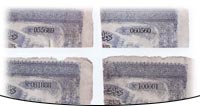
1st Emission 3rd Arrangement, 5 lira banknote corners ( OBA).
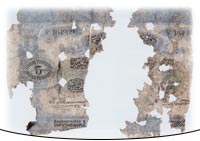
3rd Emission 1st Arrangement, 5 lira banknote pieces, ( OBA) 164989 serial number. Exported on 20 July 1885. Foster and Beauvais signature can be read.
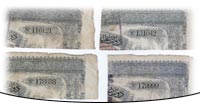
3rd Emission 1st Arrangement 5 lira banknote corners ( OBA).
1st Emission 2 lira banknote (TL), 019269 serial banknote, exported on the 27th November 1869. With the seal of Aristidi Bey and the signatures of Alleon and Smythe. Canceled with the word ANNULE written on the face of the note and it is understood from the perforation PAYE that it was paid out. According to bank records, this note was cancelled on 12 September 1870.
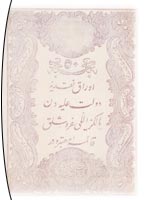
50 kurush paper money (TL), with the seal of Murad V, 2-31208 serial number. According to the records of the Ottoman bank this note was numbered on 5th October 1876 with the seal of Ottoman Finance Minister Galib.
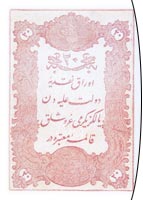
20 kurush paper money with the seal of Murad V, (TL) 2-31208 serial number. According to the records of the Ottoman bank this note was numbered on the 30th August 1876, the day that Murad was put off the throne. With the seal of Ottoman Finance Minister Galib.
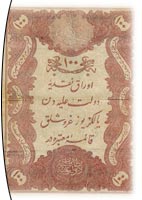
100 kurush paper money with the seal of Abdülhamid II, (IA) 1838415 serial number. According to the records of the Ottoman bank, it was numbered on 30 January 1877. With the seal of Ottoman Finance Minister Galib.
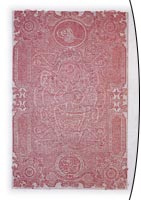
5 Kurush paper money with the seal of Abdülhamid ,(TL) 103-30924 serial number. According to the records of the Ottoman bank, it was numbered on 13th June 1877. With the seal of Ottoman Finance Minister Mehmed Kani.
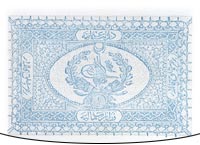
1 kurush paper money 's green and blue examples. With the seal of Abdülhamid (TL). According to the records of the Ottoman bank, the blue one numbered 9-00022 on 21st February 1877 and the green one 242-00068 on 15 April 1878. The first carries the seal of Ottoman Finance Minister Galib and the second Sultan Yusuf Ziya.
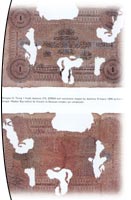
2nd Emission 2nd Arrangement, 1 Lira banknote, (TL) 029054 serial number. Exported on the 8th November 1890. With the seal of Mazhar Bey and the signatures of Vincent and Beauvais.
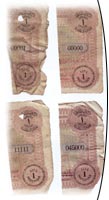
2nd Emission 1 lira banknote corners (OBA) on three of them (00001, 08000, 11111) 1 Arrangement and one (045000) 11 arrangement.
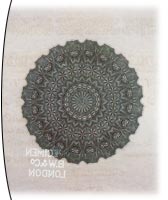
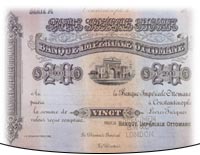
A large coupon safe bill used like a banknot 20 lira sample (TL) with perforated writing on the front and back saying "SPECIMEN B:W:&C" it is understood to have been sent by the printers Bradbury Wilkinson&Co. This specimen was printed within the first twenty notebook stubbs and carries both 0001-2000 on this safe bill name of the payee and payer was left blank with the purpose of being filled in later and it shows it before it was filled in.
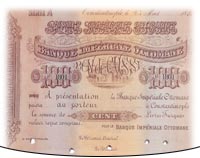
Large coupon used as a banknote for 100 Lira Safe bill. On the back and the front face (OBA) as in the 20 Lira specimen the stubbs and was not in a legal condition.
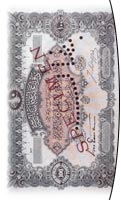
IVth Emission 1st 100 Lira banknote specimen (TL). This sample was issued without a number and is stamped" SPECIMEN" and the word "battal" is written with perforations. The signature of Deffes and Tristam can be read. As shortly after it was exported, Sultan Abdülhamid II was dethroned, it was reurned as an import and this issue is not to be found as a real note.
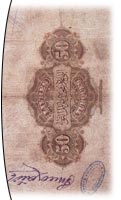
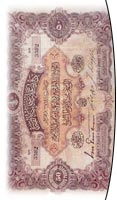
IVth Emission 50 Lira banknote front and back face. (TL) 3582 serial number. Exported on 8th April 1910. It carries the signature of Hamid Bey, Deffes and Tristam. On the back face it has the signature "Nikolaidis" and is stamped "Krikor N Garabedian". In order to keep this note the names of a jeweller and merchant are written on it.
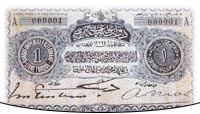
Vth Emission Bank of Istanbul, 1 Lira banknote front and rear face. (TL) and carries the serial number 000001 A. This was the first banknote to be exported on 17 August 1914. It carries the signature of Ferid Bey, Nias and Tristam. This banknote was printed by Zellich printers and the Ottoman bank safe receipt is pressed on the rear. The safe receipt on the bank is formed in thin red lines. This banknote is the only known example of an issue that was not known until today.
The safe receipt of the Istanbul 1 Lira notes were brought one on top of the other and it is understood that from each receipt four units 1 Lira note were pressed.
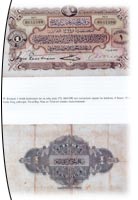
VIth Emission 1 lira banknote front and rear face, (TL) 0641590 serial number. Exported on the 4th November 1914. It carries the signature of Ferid Bey, Nias and Tristam.
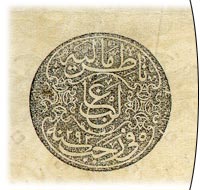
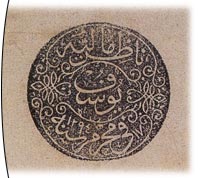
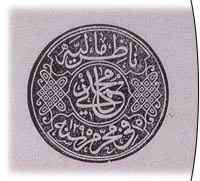
1876-1878 paper money rear face, with the stamp of the treasury minister.
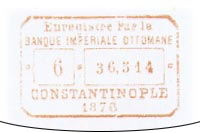
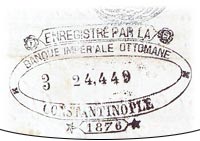
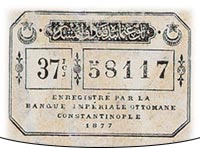
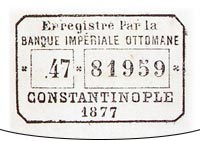
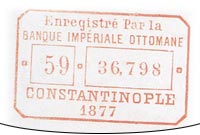
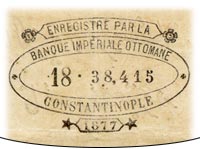

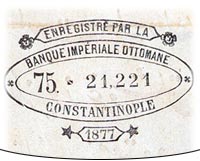
1876 -1878 paper money rear face with the stamp of the Ottoman bank. These stamps on the 1 Lira notes all said "Enregistre par la banque imperiale ottomane Constantinople". (recorded by the Ottoman bank - Istanbul.) They carry the date of 1876 or 1877.

This note is very important as it clarifies the date of coming into power of Orhan Gazi, which was disputed in old Ottoman times.
Various dates from 710=1310 to 727=1327 were alleged about the death of Osman Gazi, thus coming into power of Orhan. On the other hand, it was understood from a deed dated 723=1323 that Osman Gazi was alive at that time, and from another deed dated 724=1324 that Osman had died in 724 and Orhan had come to power in his place.
Those coins made it definite that Orhan was the emperor in 724=1324.
No: 1 Silver Coin (AR) AE 18 m/m, 1 g
Front face: Lâilâhe illallah Muham-medün Resulullah
Rear face: Lehu duribe Orhan bin Osman Bursa 3

No: 2 Silver coin (AR) 13 m/m, 0,92 g
Front face: Sultan bin sultan Mehmed bin Bayezid Zide ümrühü
Rear face: Duribe Amasya 812 Hullide mülkühü Han
Mehmed I (Çelebi) had silver coins printed at several places in 816=1413 with the expression (Sultan bin Sultan Mehmed bin Bayezid Han). While this coin is the same as the coins dated 816, its date is 812, not 816. It is understood that the date error of this coin is due to the reverse printing of Arabic numeral 6.
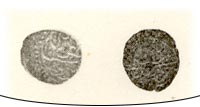 No: 4 Silver Coin (AR) 11 m/m, 0,62 g
No: 4 Silver Coin (AR) 11 m/m, 0,62 g
Front face: Sultan Selim Han Bin Bayezid Han
Rear face: Azze nasrühü duribe Harput sene 917
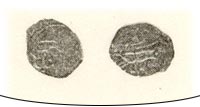 No: 5 Silver Coin (AR) 12 m/m, 0,55 g
No: 5 Silver Coin (AR) 12 m/m, 0,55 g
Front face: Sultan Selim Şah bin Bayezid, sene 668 Ruha
Rear face: Azze nasrühü
These belong to Selim I. Selim succeeded to the throne on 918=1512. However, the coin no. 4 bears the date 917. Since Sultan Selim became the emperor on 24 April 1512 = 7 Safer 918, it is understood that the date of 917 was falsely printed on the coin no. 4. It should be accepted that the numeral 8 in the old writing was written reverse on this coin and formed a 7.
 This coin is a golden coin of Süleyman I (Kanuni). It was printed in Jeddah. It reads (Süleyman bin Beyazid). Süleyman I assigned the name of his grandfather Beyazıd Khan on this coin as well. Different from other coins, it bears the expressions of "lillah" on its front face and "el-izzi" on its rear face. Jeddah is a large city at the coast of the Red Sea and is also the harbor of Mecca.
This coin is a golden coin of Süleyman I (Kanuni). It was printed in Jeddah. It reads (Süleyman bin Beyazid). Süleyman I assigned the name of his grandfather Beyazıd Khan on this coin as well. Different from other coins, it bears the expressions of "lillah" on its front face and "el-izzi" on its rear face. Jeddah is a large city at the coast of the Red Sea and is also the harbor of Mecca.
No: 6 Golden coin (AV) 18 m/m, 3,55 g
Front face: Daribün nadri lillâh sahibül izzi vennasri filberri velbahr
Rear face: Es sultan-ül izzi Süleyman bin Selim bin, Bayezid Han azze nasrühü duribe Cidde sene
 This is a coin of Süleyman I (Kanuni). This coin was printed in Balya. Balya is a town of Balıkesir province and no coin printed in Balya was encountered until now among the Ottoman coins. In the book of Peter Jaeckel published in 1968 in Wiesbaden, showing the coining locations, the names of this city and town are not included. In this regard, Jeddah and Balya are added in the list of coining places of Ottoman coins.
This is a coin of Süleyman I (Kanuni). This coin was printed in Balya. Balya is a town of Balıkesir province and no coin printed in Balya was encountered until now among the Ottoman coins. In the book of Peter Jaeckel published in 1968 in Wiesbaden, showing the coining locations, the names of this city and town are not included. In this regard, Jeddah and Balya are added in the list of coining places of Ottoman coins.
No. 7 Silver Coin (AR) AE 13,5 m/m, 0,70
Front face: Sultan Süleyman Şah bin Selim Han Balya sene 926
Rear face: Azze na (srühü) duribe
 This is a coin of Sultan Süleyman I. In the catalog called Meskükât-ı Osmaniye of Halil Ethem, there is an explanation as (in a private collection another Aleppo copper coin dated 934 was seen an its front face read "sikke-i sahib-i zaman" its rear face "azze nasırühü duribe Halep 934") on this coin. Although the drawing of this copper coin is not good, it is legible. This coin was not encountered in other catalogs.
This is a coin of Sultan Süleyman I. In the catalog called Meskükât-ı Osmaniye of Halil Ethem, there is an explanation as (in a private collection another Aleppo copper coin dated 934 was seen an its front face read "sikke-i sahib-i zaman" its rear face "azze nasırühü duribe Halep 934") on this coin. Although the drawing of this copper coin is not good, it is legible. This coin was not encountered in other catalogs.
No. 8 Copper Coin (AE) AE 12 m/m, 3,05 g
Front face: Sikke-i sahib-i zaman
Rear face: Azze nasrühü duribe
 This is also a coin of Sultan Süleyman I and printed in Constantinople. However, although the date is generally 926 in the coins cut in Constantinople, the date on this coin is 962. It is concluded that this coin was also falsely made, and the order of the numerals 2 and 6 were written wrong.
This is also a coin of Sultan Süleyman I and printed in Constantinople. However, although the date is generally 926 in the coins cut in Constantinople, the date on this coin is 962. It is concluded that this coin was also falsely made, and the order of the numerals 2 and 6 were written wrong.
No. 9 Silver Coin (AR) AE 12 m/m, 0,75
Front face: Sultan Süleyman Şah bin Selim Han
Rear face: Hullide mülkühü duribe Kostantaniye 962
 This is a silver coin of Selim II. It is the only coin printed in Hudeyde. No similar coin was encountered in the catalogs until now.
This is a silver coin of Selim II. It is the only coin printed in Hudeyde. No similar coin was encountered in the catalogs until now.
No. 10 Silver Coin (AR) AE 10 m/m, 0,58 g
Front face: Sultan Selim şah (bin) Süleyman Han
Rear face: (Azze) nasrühü duribe Hudeyde
 This coin is a silver drachma of Murad III printed in Baghdad. It has a Grand Seal and inside the seal "Gazi" is written.
This coin is a silver drachma of Murad III printed in Baghdad. It has a Grand Seal and inside the seal "Gazi" is written.
No. 11 Silver drachma (AR) AE 18 m/m, 2,95 g
Front face: Tuğra han azze nasri.ihü (duribe) Bağdat
Rear face: Sultan Murad Han Gazi bin (Selim)
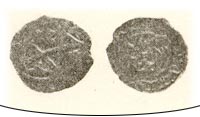
This coin is also a copper coin of Murad III. It was printed in 982 in Erzurum. On its rear face, there is a star with six corners inside Mühr-ü Süleyman (Cachet de Salomon). Although no name is written on either face of the coin, it is of Ottoman copper type and its date corresponds to the throne of Murad III.
No. 12 Copper coin (AE) AE 16 m/m, 1,40 g
Front face: (In the middle) Erzurum, ((In the periphery) Duribe 982
Rear face: Star with 6 corners inside Mührü Süleyman
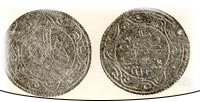 This coin is a golden coin called Rumî, printed in the 13th year of the reign of Mahmud II (Adlî). Having been printed in the 13th year of the reign constitutes the characteristic of this coin. Because it was known that the Rumî golden coins were printed from the 9th year until the end of 12th year of the reign of Mahmud II. No similar golden coin printed in the 13th year of the reign was encountered up to now.
This coin is a golden coin called Rumî, printed in the 13th year of the reign of Mahmud II (Adlî). Having been printed in the 13th year of the reign constitutes the characteristic of this coin. Because it was known that the Rumî golden coins were printed from the 9th year until the end of 12th year of the reign of Mahmud II. No similar golden coin printed in the 13th year of the reign was encountered up to now.
No. 13 Golden coin (AV) AE 28 m/m, 4,43 g
Front face: Grand Seal (with a flower to the right)
Rear face: (13) duribe fi Kostantiniye 1223
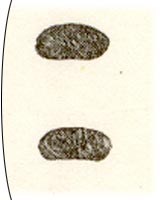 It was printed with decorative gold called "Pul" at the time of Sultan Mahmud II. It is estimated that these "pul"s were used as accessory by women at that time.
It was printed with decorative gold called "Pul" at the time of Sultan Mahmud II. It is estimated that these "pul"s were used as accessory by women at that time.
No. 14 Decorative gold - pul AE 5-9 m/m, 0,12 g
Front face: Mahmud
Rear face: Time
 No. 15 AE 9 m/m, 0,40 g
No. 15 AE 9 m/m, 0,40 g
Front face: Moon
Rear face: Star
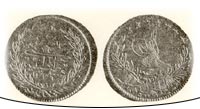 Although golden coins printed during the first and second years of the reign of Mehmed VI (Vahidüddin), the last Ottoman Emperor, which lasted 4 years, 3 months and 28 days between 1336-1341 (1918-1922), are found, those printed in the consequent years are very rarely encountered.
Although golden coins printed during the first and second years of the reign of Mehmed VI (Vahidüddin), the last Ottoman Emperor, which lasted 4 years, 3 months and 28 days between 1336-1341 (1918-1922), are found, those printed in the consequent years are very rarely encountered.
No. 17 Golden coin (AV) Fiver AE 34,5 m/m, 35,82 g
Front face: Grand Seal, Year 3 (500)
Rear face: Azze nasrihü duribe fi Kostantiniye 1336
Reference: Osmanlı Bankası Arşivi ve Tahsin İşbiroğlu Koleksiyonundan Osmanlı Bankası Banknotları (1863-1914) (Ottoman Ban Notes from the Ottoman Bank Archive and Tahsin İşbiroğlu Collection (1863-1914). Istanbul, 1999.








